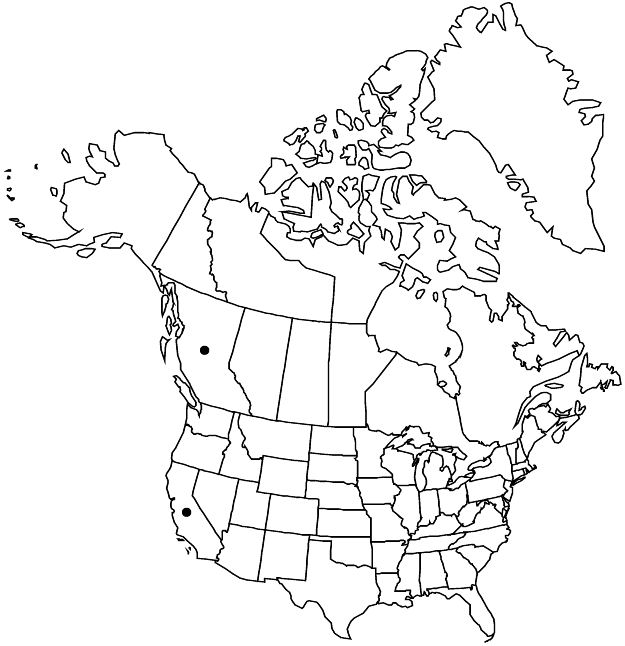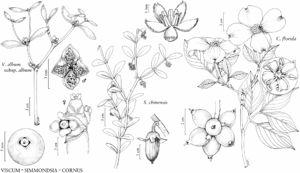Viscum album subsp. album
Shrubs, dioecious, forming globose infections, to 2 m diam. Leaves green to yellowish green; blade oblanceolate or obovate-oblong, 3–8 cm, leathery, base attenuate, apex rounded, surfaces glabrous; venation parallel, veins 3–7. Staminate inflorescences simple dichasia, consisting of 3 flowers subtended by 2 bracts fused into cupule. Pistillate inflorescences compound dichasia, usually 3-flowered; primary peduncle 4–6 mm; lateral flowers each subtended by 1 bract; terminal flower subtended by 2 bracts at apex of 2 mm secondary peduncle. Staminate flowers sessile, 5 mm; petals yellow; anthers white, covering most of petal adaxial surface. Pistillate flowers sessile, somewhat flattened, 2 mm; stigma cushion-shaped. Berries white, globose, 6–10 mm, apex with dark markings representing stigma surrounded by petal scars. 2n = 20.
Phenology: Flowering Feb–Apr; fruiting Nov–Dec.
Habitat: Orchards, urban forests.
Elevation: 60–100 m.
Distribution

Introduced; B.C., Calif., Europe, w Asia
Discussion
Subspecies album parasitizes many different tree species, but is most often found on Crataegus, Malus, Populus, Robinia, and Tilia. It was inoculated onto trees in the Sebastopol area, Sonoma County, California, around 1900 by the horticulturalist Luther Burbank, who wished to cultivate it for Christmas decorations (R. F. Scharpf and W. McCartney 1975). Although this source remained localized for several decades, by the 1980s the population had been spread to 114 square kilometers by birds such as cedar waxwings (Bombycilla cedrorum) and American robins (Turdus migratorius) (F. G. Hawksworth and R. F. Scharpf 1986). A survey in 1996 showed the mistletoe infestation occupied 220 square kilometers but remained localized to Sonoma County (Scharpf 2002). In 1988, European mistletoe was found in Victoria, British Columbia, parasitizing Malus, but the population had apparently been purposely introduced more than 37 years before (C. E. Dorworth 1989). This naturalized mistletoe is categorized by the California Department of Food and Agriculture as a Noxious Weed List B because it has potential to negatively impact orchard crops. Viscum album is being studied extensively because it contains lectins that appear to have anticancer efficacy (A. Bussing 2000).
Selected References
None.
